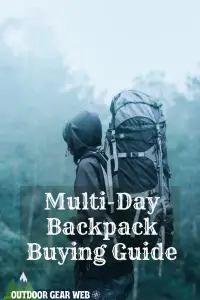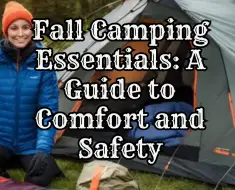
Planning a thrilling multi-day adventure? The right backpack is essential to ensure a comfortable and enjoyable trip. With a vast array of options available, selecting the perfect multi-day backpack can be overwhelming. But worry not! In this comprehensive multi-day backpacks buying guide, we’ll walk you through the key factors to consider when choosing the ideal backpack for your journey.
Start your multi-day backpacking adventure here with our Top 5 multi-day backpacks
Multi-Day Backpacks Buying Guide: Assess Your Needs
Before diving into the world of multi-day backpacks, start by assessing your specific needs. Consider the length of your trips, the type of terrain you’ll be traversing, and the weather conditions you may encounter. Knowing these details will help you determine the appropriate size, features, and materials needed for your backpack.
By assessing these aspects of your multi-day adventures, you’ll gain a clear understanding of what features and materials your ideal backpack should possess. Armed with this knowledge, you’ll be ready to explore the diverse range of backpack options available and find the perfect companion for your thrilling multi-day excursions. Remember, investing time in this evaluation will enhance your overall trekking experience and ensure that your backpack is a reliable partner on every step of the journey.
Trip Duration:
Consider the length of your multi-day trips. Are you planning weekend getaways, week-long expeditions, or even longer excursions? The duration of your adventures will directly impact the size and capacity of the backpack you should choose. Longer trips typically require larger packs to accommodate all the necessary gear and supplies.
Terrain and Activities:
The type of terrain you’ll be traversing plays a significant role in determining the appropriate backpack features. Will you be hiking through rugged mountain trails, dense forests, or open plains? If your journey involves off-trail exploration, look for a backpack with sturdy construction and reinforced bottom for added durability. For alpine or technical treks, consider a pack with gear loops and attachment points for carrying climbing equipment.
Weather Conditions:

Mother Nature can be unpredictable, so it’s essential to account for potential weather conditions during your multi-day adventure. If you expect to encounter rain or snow, prioritize a backpack with weather-resistant materials or a built-in rain cover to protect your gear. Ventilation features like breathable back panels and moisture-wicking fabrics are excellent options for hot and humid climates.
Load Weight:
Another crucial factor is the weight you’ll be carrying in your backpack. Consider the total weight of your gear, food, and water. A well-designed pack will distribute the load evenly and prevent discomfort or strain on your shoulders and back. Look for backpacks with sturdy frames and supportive suspension systems to handle heavier loads with ease.
Special Requirements:
Beyond the basics, think about any specific needs or activities that might influence your backpack choice. For photographers, a backpack with dedicated camera compartments may be essential. For backcountry adventurers, hydration compatibility and easy-access water bottle pockets might be top priorities.
Personal Comfort:
Your comfort on the trail is of utmost importance. Ensure the backpack you choose fits well and is adjustable to suit your body size and shape. Padded shoulder straps, hip belts, and back panels contribute to a comfortable carrying experience, even during long hikes.
Learn more about backpacking kitchen must-haves
Multi-Day Backpacks Buying Guide: Size

The backpack’s capacity is crucial when planning multi-day adventures. A larger capacity allows you to carry more gear, but keep in mind that it may add extra weight. As a general guideline, opt for a pack with a volume of 50 to 70 liters for week-long trips, and around 30 to 50 liters for shorter excursions.
The size of your backpack will be determined by the kind of trekking you will be undertaking and the duration of your journey. If you want to go on any difficult or overnight journeys, the size of your backpack should match the amount of stuff you’ll need.
Backpack sizes are measured in liters and vary from modest 30L daypacks to huge 80-85L backpacks. If you need help determining what size of backpack to purchase, phone your local outdoor gear shop and ask them.
Multi-Day Backpacks Buying Guide: Durability and Weather Resistance
Durability is an absolute must when it comes to selecting a backpack for multi-day trips. Your backpack will endure various challenges, from rough terrains and abrasions to heavy loads and changing weather conditions. To ensure it stands the test of time and keeps your gear safe and secure, pay close attention to the following aspects:
Investing in a durable and weather-resistant backpack will give you peace of mind throughout your multi-day adventures. A well-built pack will not only protect your gear but also provide the confidence and reliability needed to tackle challenging trails and changing weather conditions. Remember, a durable backpack is not just an accessory; it’s an indispensable companion that will accompany you on countless unforgettable journeys. So choose wisely and set off on your multi-day adventures with unwavering confidence in your gear!
High-Quality Materials:
Start by inspecting the materials used in the construction of the backpack. Look for packs made from durable fabrics like ripstop nylon, ballistic nylon, or high-denier polyester. These materials offer excellent resistance to tears and punctures, ensuring your backpack can handle the ruggedness of the outdoors.
Reinforced Stitching:
The stitching is an often-overlooked but crucial aspect of a backpack’s durability. Double or triple stitching in critical areas, such as shoulder straps, hip belts, and load-bearing points, significantly enhances the pack’s strength and longevity. Reinforced stitching prevents seams from unraveling, even under substantial weight and strain.
Reliable Zippers:
Zippers are among the most frequently used components of a backpack. Opt for high-quality, robust zippers that move smoothly without snagging or catching on fabric. Look for waterproof or water-resistant zippers, especially in compartments that might be exposed to the elements, to safeguard your gear from rain and moisture.
Check out these tips to feel safe when camping.
Weather Resistance:
Multi-day treks often involve encounters with unpredictable weather. Having a weather-resistant backpack is crucial to protect your valuable gear from rain, snow, or damp conditions. Some backpacks come with integrated rain covers that can be quickly deployed to shield the entire pack from water. Alternatively, water-resistant fabrics and coatings can also provide effective protection.
Durability vs. Weight:
While durability is essential, finding the right balance between durability and weight is crucial for multi-day backpacking. Backpacks constructed with heavy-duty materials might offer superior longevity but can add unnecessary weight to your load. Look for lightweight yet durable materials that offer the best of both worlds.
Multi-Day Backpacks Buying Guide: Expansion

In the quest for the perfect multi-day backpack, having the option for expansion can be a game-changer. There are instances where you might need to carry extra gear or supplies, or perhaps you want the flexibility to bring back souvenirs or gifts from your adventure. Whatever the reason, having an expandable backpack can save you from the inconvenience of leaving behind essential items.
Here’s why an expansion option is a valuable feature to look for in your chosen multi-day backpack:
Versatility:
An expandable backpack offers versatility that standard-sized packs may not provide. Whether you’re on a short weekend getaway or an extended expedition, you have the freedom to adjust the pack’s size according to your needs. This flexibility allows you to carry just the essentials when the trip demands it or expand the pack to its full capacity for longer journeys.
Extra Space for Unexpected Items:
During multi-day trips, you might stumble upon unique treasures, local crafts, or souvenirs that you can’t resist bringing back home. Having an expandable backpack ensures you have the extra space to accommodate these unexpected items without compromising on comfort or resorting to carrying additional bags.
Organized Packing:
Some expansion options include additional compartments or dedicated pockets that help keep your gear organized and easily accessible. This feature prevents your belongings from getting jumbled up and saves you from digging through the entire pack to find what you need.
Efficient Load Distribution:
Despite the extra space, a well-designed expandable backpack maintains a balanced load distribution. Properly distributing weight throughout the pack ensures your comfort and minimizes strain on your body, even when carrying a larger load.
Check out Bexar Outfitters on Youtube for some other great backpacking content!
Multi-Day Backpacks Buying Guide: Features
When purchasing a multi-day backpack, you’ll come across various features designed to enhance comfort, organization, and durability during your adventures.
Remember to prioritize the features that align with your specific needs and preferences, as the perfect multi-day backpack is one that complements your unique style of adventure.
22 common features to look for:
- Capacity: Different sizes accommodate varying trip lengths and gear.
- Expansion Option: Allows the backpack to increase in volume for additional storage.
- Adjustable Torso Length: Ensures a custom fit.
- Padded Shoulder Straps and Hip Belts: Provides comfort and support for heavy loads.
- Ventilated Back Panel: Enhances airflow to reduce sweat and discomfort.
- Frame Type: Internal frame for improved weight distribution or external frame for better stability and load-carrying capacity.
- Load Lifter Straps: Helps balance weight and keeps it close to your body.
- Compression Straps: Allows you to tighten or loosen for load stabilization.
- Hydration Compatibility: A sleeve or compartment to hold a water bladder and hose ports.
- Dedicated Sleeping Bag Compartment: Easy access for sleeping bags.
- Rain Cover: Built-in or included cover to protect the pack from rain and moisture.
- Waterproof or Water-Resistant Materials: Keeps your gear dry during wet conditions.
- Multiple Compartments and Pockets: Organizes gear and keeps items easily accessible.
- Hip Belt Pockets: Additional storage for small essentials like snacks, a phone, or a camera.
- Trekking Pole/Ice Axe Attachments: Convenient loops or bungee cords to secure these tools.
- Gear Loops and Attachment Points: For carrying additional gear or equipment externally.
- Convertible Daypack: Detachable smaller pack for day trips or exploring.
- Integrated Safety Whistle: A built-in safety feature for emergencies.
- Side Access Zipper: Provides easy access to the main compartment.
- Load Stabilizers: Straps that anchor the load closer to your body, improving balance and stability.
- Sternum Strap: Helps distribute weight.
- Lockable Zippers: Offers additional security for your belongings.
Multi-Day Backpacks Buying Guide: Load Distribution

Load distribution is a crucial aspect to consider when purchasing a multi-day backpack. Properly distributing the weight of your gear can make a significant difference in your overall hiking comfort and reduce fatigue during long journeys. A well-designed backpack will prioritize weight distribution to your hips rather than your shoulders, as your hips can better support the load without straining your upper body. By evenly distributing the weight, you’ll experience less strain on your shoulders and back, allowing you to hike longer distances with ease.
To ensure the best load distribution for your specific body type and needs, it’s highly recommended to visit your local outdoor outfitting shop and try on a few backpacks. Getting a hands-on experience with different models will allow you to feel how each backpack distributes the weight. Pay close attention to how the hip belt sits on your hips and how the shoulder straps rest on your shoulders. The ideal backpack should snugly fit your body and distribute the majority of the weight to your hips, providing optimal stability and comfort during your multi-day adventures. Prioritizing load distribution will not only enhance your hiking experience but also prevent unnecessary strain and discomfort, allowing you to focus on enjoying the breathtaking scenery and unforgettable moments on the trail.
Want to test your hand at ultralight backpacking? Check out these items first.
Multi-Day Backpacks Buying Guide: Ventilation
Ventilation is a crucial factor to consider when buying a multi-day backpack, especially if you’ll be hiking in hot and humid conditions. A well-designed ventilation system helps prevent excessive sweating and discomfort by promoting airflow between your back and the backpack. Look for backpacks with a breathable back panel, often made with mesh materials, that allows air to circulate freely, keeping your back cool and dry during long hikes. Additionally, check the shoulder straps for mesh padding to ensure they don’t cause unnecessary heat retention and irritation on your shoulders. Proper ventilation is key to maintaining your comfort and preventing sweat-induced discomfort, allowing you to stay focused on enjoying your adventure to the fullest.
Before making your purchase, take the time to inspect the ventilation system of the backpack you’re considering. A good ventilation design will not only help regulate your body temperature but also reduce the risk of chafing and rashes caused by prolonged contact with a sweaty back. The presence of breathable mesh on the back panel and shoulder straps is a positive sign that the backpack is designed with comfort in mind. Additionally, some backpacks come with special ventilation channels or ridges that further enhance airflow, providing an added level of cooling during hot and strenuous hikes. By prioritizing ventilation in your multi-day backpack selection, you’ll be better equipped to tackle challenging trails with ease and maintain a pleasant and comfortable hiking experience.
Choosing a backpack with superior ventilation will ensure you can conquer any trail, no matter how challenging the weather, with maximum comfort and enjoyment.
Multi-Day Backpacks Buying Guide: FAQs
What Is The Price Of A Hiking Backpack?
Varying backpacks have different prices due to their sizes, range, features, etc. A good backpack usually costs between $50 and $200. However, certain things cost more than $200 and, in rare cases, more than $300. It all depends on how much perfection you want.
What Should The Weight Of A Hiking Backpack Be?
Hiking backpacks should be light in weight since the weight inside (which you will put in it) will make it heavier. As a result, a heavyweight backpack will be nothing more than a burden. They should be at most 20% of your body weight to function properly.
What Dimensions Should A Hiking Backpack Have?
Hiking backpacks have various purpose straps such as the chest, shoulder, etc. Please don’t rush through things; instead, maintain them smoothly. Tighten the straps until they are snug over your hips and up your chest, then fine-tune the fit at the shoulders and waist.
Why not take a book with you to enjoy some great reading on the trail?
Multi-Day Backpacks Buying Guide Conclusion
Investing in the right multi-day backpack is an investment in your overall adventure experience. Consider your needs, choose the appropriate capacity, prioritize comfort and fit, and focus on durability and accessibility. With these essential factors in mind, you’ll be well-prepared to embark on your next thrilling multi-day journey with confidence and style.
Remember, a well-chosen backpack is your loyal companion on the trail, ensuring you can focus on enjoying the breathtaking landscapes and unforgettable moments that multi-day adventures have to offer. Happy trekking!







